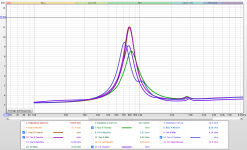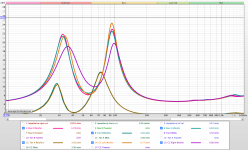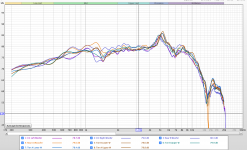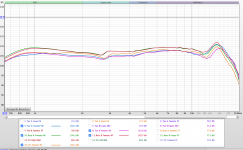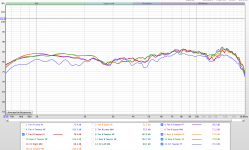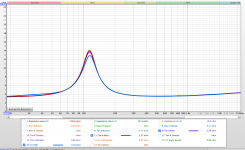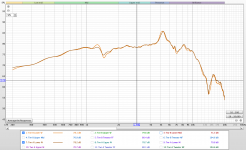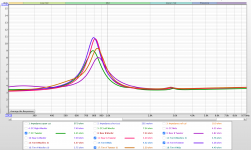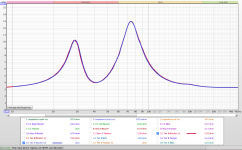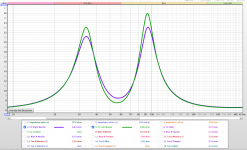Can't say I worried about that resistor at all. Maybe that's my bad? I just grabbed some random assortment off amazon at the time.
You're good, it's no worries. I guess getting higher tolerance resistors isnt going to change too much since I have to input the measured resistor value into REW anyways.
But I have finished the impedance measurements and wanted to shoot them your way. Im going to be doing the FR of the CC here soon. But here are screen captures of all the speakers.
Capture 1: The tweeters.
Looks like I should move the tweeter on Rear B to Tower A since those match so well. Then the tweeter on Twr A can go to the CC since that one seems like an odd ball out. Then the CC tweeter can go to Rear B.
Capture 2: The woofers
These actually look pretty good except the CC right woofer. That one is like the lonely one out. Do not know about that.
Capture 3: The mids
They look good and consistent to me.
But I have finished the impedance measurements and wanted to shoot them your way. Im going to be doing the FR of the CC here soon. But here are screen captures of all the speakers.
Capture 1: The tweeters.
Looks like I should move the tweeter on Rear B to Tower A since those match so well. Then the tweeter on Twr A can go to the CC since that one seems like an odd ball out. Then the CC tweeter can go to Rear B.
Capture 2: The woofers
These actually look pretty good except the CC right woofer. That one is like the lonely one out. Do not know about that.
Capture 3: The mids
They look good and consistent to me.
Attachments
Alright I finished the FR testing and have screenshots for you!
Keep in mind I did forget to remember the volume my computer was at for the headphone out. So for right now, the dB on the CC measurements might be slightly off. For now, trying to look at the shape and curves to see how it matches.
Capture 1: The woofers
Honestly all pretty consistent with their given enclosure they are screwed to, I dont have much to say about those.
Capture 2: The mids
Once again they seem very consistent from each speaker and placement. Like both Upper Mids on the towers look that same, as well as lower. Also the CC mids look the same.
Capture 3: The tweeters FF
Honestly super small differences from what I can see. Looks good to me.
Capture 4: The tweeters NF
Same thing as before with the FF for me.
Lemme know whatcha think!
Keep in mind I did forget to remember the volume my computer was at for the headphone out. So for right now, the dB on the CC measurements might be slightly off. For now, trying to look at the shape and curves to see how it matches.
Capture 1: The woofers
Honestly all pretty consistent with their given enclosure they are screwed to, I dont have much to say about those.
Capture 2: The mids
Once again they seem very consistent from each speaker and placement. Like both Upper Mids on the towers look that same, as well as lower. Also the CC mids look the same.
Capture 3: The tweeters FF
Honestly super small differences from what I can see. Looks good to me.
Capture 4: The tweeters NF
Same thing as before with the FF for me.
Lemme know whatcha think!
Attachments
Just fyi about REW - you can change trace colors when the program is creating too many lines that are too similar in color. Click on the paintbrush icon in the left side smaller windows/boxes. And you can add or subtract dB from any trace if it helps for comparison's sake. Click the Control icon near the top right and manipulate the offset button. You can choose to permanently add this to the data file or not as well.
Looking at impedance, for the tweeters and mids I'm not too concerned by any small differences at the resonant peaks because those frequencies won't be in the passband. They'll be rolled off probably by at least 25-35dB by the xo's, maybe even a little bit more.
So for the tweeters, I'm more concerned about any differences from about 1200Hz and up (I'm assuming a xo point somewhere around 2500Hz) since it's the interaction between the xo and the driver's impedance which creates a change in the FR. So in that regard, the CC tweeter is already the outlier - impedance is sitting below all the others from about 1000Hz all the way up, albeit it is still just a small amount. The best matches look like tower A and rear B (you've got 2 tweeter Z's labeled rear B, I'm assuming the one with the lower ohm impedance peak is rear A) and I would put those up front in the 2 towers. Tower B and rear A tweeters would therefore go in the surrounds.
For the mids, I can't see the impedances above about 300Hz which is where you will be using them so it's hard for me to comment. But the FR's all look good and so I suspect the impedance do too.
For the woofers' impedance, first thing to note is that the valleys between peaks correspond to the tuning frequencies in ported alignments. So towers look to be tuned lower which is actually correct.
For that right CC woofer, you've got a higher tuning frequency for some reason. Could be a result of a woofer with a different resonant frequency than the rest or it could be the result of some kind of difference in any factor that affects vented tuning, ie. box volume, port length/width, amount of stuffing or possible air leakage. If any of those are different than the right CC chamber that may account for that impedance anomaly.
Otherwise the woofers look fine for matching in the 3-ways (although to be honest, NF measurements of the woofers are needed for the best accuracy there) but for the 2-ways I would still just try to match those 2 up a little better between 1000-3000Hz. Granted it is a little hard to find a good match due to different baffle diffraction effects but I think there is a better match than what you've got right now. It's a bit difficult for me with so many lines on 1 graph but you can turn them on and off in REW and should be able to match something up better than the current ones I would think.
Looking at impedance, for the tweeters and mids I'm not too concerned by any small differences at the resonant peaks because those frequencies won't be in the passband. They'll be rolled off probably by at least 25-35dB by the xo's, maybe even a little bit more.
So for the tweeters, I'm more concerned about any differences from about 1200Hz and up (I'm assuming a xo point somewhere around 2500Hz) since it's the interaction between the xo and the driver's impedance which creates a change in the FR. So in that regard, the CC tweeter is already the outlier - impedance is sitting below all the others from about 1000Hz all the way up, albeit it is still just a small amount. The best matches look like tower A and rear B (you've got 2 tweeter Z's labeled rear B, I'm assuming the one with the lower ohm impedance peak is rear A) and I would put those up front in the 2 towers. Tower B and rear A tweeters would therefore go in the surrounds.
For the mids, I can't see the impedances above about 300Hz which is where you will be using them so it's hard for me to comment. But the FR's all look good and so I suspect the impedance do too.
For the woofers' impedance, first thing to note is that the valleys between peaks correspond to the tuning frequencies in ported alignments. So towers look to be tuned lower which is actually correct.
For that right CC woofer, you've got a higher tuning frequency for some reason. Could be a result of a woofer with a different resonant frequency than the rest or it could be the result of some kind of difference in any factor that affects vented tuning, ie. box volume, port length/width, amount of stuffing or possible air leakage. If any of those are different than the right CC chamber that may account for that impedance anomaly.
Otherwise the woofers look fine for matching in the 3-ways (although to be honest, NF measurements of the woofers are needed for the best accuracy there) but for the 2-ways I would still just try to match those 2 up a little better between 1000-3000Hz. Granted it is a little hard to find a good match due to different baffle diffraction effects but I think there is a better match than what you've got right now. It's a bit difficult for me with so many lines on 1 graph but you can turn them on and off in REW and should be able to match something up better than the current ones I would think.
I actually did change the colors of the traces so you could see it better, but yeah it is pretty populated.
And yeah seems like we got the same idea on which tweeters to move around. And yeah thats my bad about two Rear Bs. The more closely matched one is Rear A.
So actually the two best matches are Tower B and Rear A.
As far as the right woofer in the CC, I really do not know what is going on. I looked back at my old testing and it wasnt that off. The ports length and everything about each chamber is exactly the same, I made sure to take extra detail to that. But I will open it up and see whats up, cuz there could very well be a part of the absorption that feel close to the woofer or something. Ill take a look for sure.
Also my bad about the mids impedance screenshot, I included a new one.
So, after I change these drivers back around. What do you suggest my next move is?
And yeah seems like we got the same idea on which tweeters to move around. And yeah thats my bad about two Rear Bs. The more closely matched one is Rear A.
So actually the two best matches are Tower B and Rear A.
As far as the right woofer in the CC, I really do not know what is going on. I looked back at my old testing and it wasnt that off. The ports length and everything about each chamber is exactly the same, I made sure to take extra detail to that. But I will open it up and see whats up, cuz there could very well be a part of the absorption that feel close to the woofer or something. Ill take a look for sure.
Also my bad about the mids impedance screenshot, I included a new one.
So, after I change these drivers back around. What do you suggest my next move is?
Attachments
So I looked at the FR in REW, looking at the factors I know and the ones you have suggested. There seems to be no large differences in FR between all the drivers in their respective speaker and location. The only slightly off thing are the woofers in the rears. Like you said, I would want to try and match them close also up to 3kHz. Which the actually do, the only difference is from 1.1kHz to 1.4kHz they are off in gain and shape. But, all the other drivers pair so well together that this does not seem like the biggest deal to me. Also, I could have been slightly off axis for one of the rear FR measurements. But overall, it seems really good.
So, the only thing I need to do is swap the tweeters in Rear A and Tower A.
So, the only thing I need to do is swap the tweeters in Rear A and Tower A.
If the rear woofer measurements are good, I've circled what I don't like about them below. That's a fair difference actually right in the important midrange. The next pic is your lower woofers in the towers. That's a much better match through that frequency range. So I would probably swap those around too.
Great match on the mid impedances btw.
Also my mistake - I meant Tower B and one of the rear tweeter impedances looked like the best match. The FR's way up above 10kHz might be a little more similar too.
So after swapping those drivers around, it's time to complete all the measurements. I'll write you up a list shortly and see if I can get it right this time, lol. Then we find the relative acoustic centers of the mids and woofers in the different speakers and then it's xo time. That's probably the most fun for me.
Great match on the mid impedances btw.
Also my mistake - I meant Tower B and one of the rear tweeter impedances looked like the best match. The FR's way up above 10kHz might be a little more similar too.
So after swapping those drivers around, it's time to complete all the measurements. I'll write you up a list shortly and see if I can get it right this time, lol. Then we find the relative acoustic centers of the mids and woofers in the different speakers and then it's xo time. That's probably the most fun for me.
Attachments
I was thinking about changing it out with one of those as well, but didnt think much of it. But yeah I will do that!
So not much to switch around which is nice haha.
Sounds great, thank you Chris! I will be patiently waiting the arrival of your list!
So not much to switch around which is nice haha.
Sounds great, thank you Chris! I will be patiently waiting the arrival of your list!

Hey Keil, I've just got some things to do this afternoon so it won't be until this evening.
You've actually picked up a lot of knowledge at this point so if you feel like putting a measurement list together yourself and then we can compare, give it a shot.
You've actually picked up a lot of knowledge at this point so if you feel like putting a measurement list together yourself and then we can compare, give it a shot.
So we've sort of been through this before starting back on page 13 I think, but one thing I missed then is that when you have multiple drivers combined in a single chamber, you are going to be better off treating them as a single unit in terms of measuring the FR, Z and acoustic centers and in terms of the xo design. There are some ways to get around this but why complicate matters unnecessarily?
Also I think I mentioned before that there is more than 1 way to measure speakers. For a beginner, I think the following is the simplest way to start out and I'm just going to leave it at that. I've just sort of re-organized it this time trying to make it a little easier to follow.
Impedance
Tweeters - you can use what you just measured, so those are done.
Mids - 3 pairs of measurements, also done
Tower Woofers - 2 pairs. If you've moved any drivers around, you might want to re-do those.
CC Woofers - 2 single drivers. Maybe double check these and/or see if you can get rid of the discrepancy between them. If not maybe average the 2 measurements out and use that.
Rear Woofers - re-measure both if drivers have been changed.
Frequency Response
- keep mic in same position for all FF measurements for each individual speaker
- keep all drivers about 2-3ft away from reflecting surfaces. Exception is the towers - with the mic at about 38" off the ground (tweeter height) and 39" away from the speaker and the lower woofer about 19" off the ground, the floor reflected path length from the woofer to the mic is about 69" and the path length travelled in 4 msec is only 54" so the reflection won't be incorporated into the measurement when using that gating time. But you won't hurt anything if you raise it up off the floor some either.
Rears: 1st double check for matching FR if you changed the drivers, same method as before.
FF: Mic distance = 18-20" on the tweeter axis
Gating = 4 msec (all potential reflected path lengths must be greater than 54"; accurate to about 250Hz)
1. Tweeter alone
2. Woofer alone
3. Tweeter and Woofer together
4. Woofer alone about 45 degrees off-axis
5. Port measurement is optional
NF: just the woofers. I think just one will be sufficient but do both if you feel like it for comparison purposes.
Towers: either on the floor or raised up will work
Mic distance = 1m on tweeter axis (mic is further back because of larger distances between drivers)
Gating = 4 msec (again, all potential reflected path lengths must be greater than 54"; accurate to about 250Hz)
FF: 1. Tweeter alone
2. Mid pair together
3. Woofer pair together
4. Tweeter and mid pair together
5. Tweeter and woofer pair together
6. Mid pair and woofer pair together
7. Mid pair alone about 45 degrees off-axis
8. Woofer pair alone about 45 degrees off-axis
NF: 1. One of the mids
2. One of the woofers
3. Port measurement is optional
CC: mic distance = 57" on tweeter axis ( twice the baffle width)
Gating = 4.5 - 5msec (you need a longer gating time because with the mic so far away, you need to make sure the gate doesn't cut off the direct sound before it even arrives at the mic; all potential reflected path lengths must be greater than 68"; accurate to about 200Hz)
FF: 1. Tweeter alone
2. Mid pair together
3. Woofer alone (either one)
4. Tweeter and mid pair together
5. Tweeter and woofer together
6. Mid pair and woofer together
7. Mid pair alone about 45 degrees off-axis
8. Woofer alone about 45 degrees off-axis
NF: 1. One of the mids
2. Left woofer
3. Right woofer (let's compare the 2 woofer FR's here since the impedance showed a difference)
4. Left and right ports (let's compare these as well to triple check the tuning)
That should keep you busy for a while!! 😀
What will help me this time around is if you can also attach your measurement files. Change the file extensions from frd or zma to txt in order to do so or maybe zip them up in a few separate folders. Whatever you can make work that's easiest. You tried attaching the REW file last time but I couldn't get it to open for me. Still haven't figured out why.
Once you get that done, you'll need to work out the acoustic centers for the various drivers and you'll also want to combine the FF and NF for the mids and the woofers. Maybe just start with the rears and then we can work through the towers and the CC after that. Then they are ready to go into XSim and you can start the xo work.
Let me know if anything isn't clear or if you can see any more mistakes. 😱
Also I think I mentioned before that there is more than 1 way to measure speakers. For a beginner, I think the following is the simplest way to start out and I'm just going to leave it at that. I've just sort of re-organized it this time trying to make it a little easier to follow.
Impedance
Tweeters - you can use what you just measured, so those are done.
Mids - 3 pairs of measurements, also done
Tower Woofers - 2 pairs. If you've moved any drivers around, you might want to re-do those.
CC Woofers - 2 single drivers. Maybe double check these and/or see if you can get rid of the discrepancy between them. If not maybe average the 2 measurements out and use that.
Rear Woofers - re-measure both if drivers have been changed.
Frequency Response
- keep mic in same position for all FF measurements for each individual speaker
- keep all drivers about 2-3ft away from reflecting surfaces. Exception is the towers - with the mic at about 38" off the ground (tweeter height) and 39" away from the speaker and the lower woofer about 19" off the ground, the floor reflected path length from the woofer to the mic is about 69" and the path length travelled in 4 msec is only 54" so the reflection won't be incorporated into the measurement when using that gating time. But you won't hurt anything if you raise it up off the floor some either.
Rears: 1st double check for matching FR if you changed the drivers, same method as before.
FF: Mic distance = 18-20" on the tweeter axis
Gating = 4 msec (all potential reflected path lengths must be greater than 54"; accurate to about 250Hz)
1. Tweeter alone
2. Woofer alone
3. Tweeter and Woofer together
4. Woofer alone about 45 degrees off-axis
5. Port measurement is optional
NF: just the woofers. I think just one will be sufficient but do both if you feel like it for comparison purposes.
Towers: either on the floor or raised up will work
Mic distance = 1m on tweeter axis (mic is further back because of larger distances between drivers)
Gating = 4 msec (again, all potential reflected path lengths must be greater than 54"; accurate to about 250Hz)
FF: 1. Tweeter alone
2. Mid pair together
3. Woofer pair together
4. Tweeter and mid pair together
5. Tweeter and woofer pair together
6. Mid pair and woofer pair together
7. Mid pair alone about 45 degrees off-axis
8. Woofer pair alone about 45 degrees off-axis
NF: 1. One of the mids
2. One of the woofers
3. Port measurement is optional
CC: mic distance = 57" on tweeter axis ( twice the baffle width)
Gating = 4.5 - 5msec (you need a longer gating time because with the mic so far away, you need to make sure the gate doesn't cut off the direct sound before it even arrives at the mic; all potential reflected path lengths must be greater than 68"; accurate to about 200Hz)
FF: 1. Tweeter alone
2. Mid pair together
3. Woofer alone (either one)
4. Tweeter and mid pair together
5. Tweeter and woofer together
6. Mid pair and woofer together
7. Mid pair alone about 45 degrees off-axis
8. Woofer alone about 45 degrees off-axis
NF: 1. One of the mids
2. Left woofer
3. Right woofer (let's compare the 2 woofer FR's here since the impedance showed a difference)
4. Left and right ports (let's compare these as well to triple check the tuning)
That should keep you busy for a while!! 😀
What will help me this time around is if you can also attach your measurement files. Change the file extensions from frd or zma to txt in order to do so or maybe zip them up in a few separate folders. Whatever you can make work that's easiest. You tried attaching the REW file last time but I couldn't get it to open for me. Still haven't figured out why.
Once you get that done, you'll need to work out the acoustic centers for the various drivers and you'll also want to combine the FF and NF for the mids and the woofers. Maybe just start with the rears and then we can work through the towers and the CC after that. Then they are ready to go into XSim and you can start the xo work.
Let me know if anything isn't clear or if you can see any more mistakes. 😱
THANK YOU!!
This is awesome and in much better detail than I could have done. I was going to get to my list but changing out the drivers proved more difficult since they stuck really well to the dry paint. Then having to fix a few mistakes cosmetically and yadda yadda.... took too long haha. But now I've got other plans tonight that I have to go to, so I wouldnt have been able to do my list today.
I will be reading through all of this in more detail tomorrow and get started.
I will also probably have questions of course😀
The only initial question I have off the bat is how you determine that the mic is on-axis to the tweeter when the mic is so far away. I dont know if you have a special method, I've just been using a red dot laser that is also a distance meter and eye-balling it.
Thank you again and again! Your help is so highly appreciated and valued!!
This is awesome and in much better detail than I could have done. I was going to get to my list but changing out the drivers proved more difficult since they stuck really well to the dry paint. Then having to fix a few mistakes cosmetically and yadda yadda.... took too long haha. But now I've got other plans tonight that I have to go to, so I wouldnt have been able to do my list today.
I will be reading through all of this in more detail tomorrow and get started.
I will also probably have questions of course😀
The only initial question I have off the bat is how you determine that the mic is on-axis to the tweeter when the mic is so far away. I dont know if you have a special method, I've just been using a red dot laser that is also a distance meter and eye-balling it.
Thank you again and again! Your help is so highly appreciated and valued!!
You're going to be slapping your head on this one - just measure the distance from the floor to the tweeter and then set the mic at the same height. Just an ancient old tape measure will do the trick. It's not going to matter if it's off 1% up or down or left or right.
And, you're welcome. 🙂
And, you're welcome. 🙂
Should I mention that the above mic positions are based on on-axis listening?
For the front L and R, that's usually the case. For the rears, that's often the case and for the CC, that's sometimes the case. So if the front L and R are not toed-in which I see every now and then or the CC isn't up at ear height or tilted upwards towards the listeners, you might want to change the mic position accordingly. Maybe for the rears too although I'm more inclined to just tune them like a normal pair of speakers, ie. on axis.
And here's my first measurement amendment - you can probably skip the 45 degree off-axis measurement on the woofers for the 3-way towers and the CC. These off-axis measurements are intended to inform the choice of the xo points but it actually won't make any difference for these smallish woofers in the 3-ways. For the higher xo points we could rely on Dayton's measurements but what fun is that?
Perhaps if anything you might take a 45 degree off-axis measurement for the pair of woofers together on the CC because of the horizontal separation of the drivers and any potential difference in response you might get off to the sides. But I don't think that one is going to matter either. But maybe give it go anyways just to be sure.
For the front L and R, that's usually the case. For the rears, that's often the case and for the CC, that's sometimes the case. So if the front L and R are not toed-in which I see every now and then or the CC isn't up at ear height or tilted upwards towards the listeners, you might want to change the mic position accordingly. Maybe for the rears too although I'm more inclined to just tune them like a normal pair of speakers, ie. on axis.
And here's my first measurement amendment - you can probably skip the 45 degree off-axis measurement on the woofers for the 3-way towers and the CC. These off-axis measurements are intended to inform the choice of the xo points but it actually won't make any difference for these smallish woofers in the 3-ways. For the higher xo points we could rely on Dayton's measurements but what fun is that?
Perhaps if anything you might take a 45 degree off-axis measurement for the pair of woofers together on the CC because of the horizontal separation of the drivers and any potential difference in response you might get off to the sides. But I don't think that one is going to matter either. But maybe give it go anyways just to be sure.
It's some great stuff here, just what I was looking for right now regarding measuring. 🙂
I found the downside to taking too much time to make something, you don't bother to remember details and don't get the hands-on practical experience needed to learn properly. lol
I found the downside to taking too much time to make something, you don't bother to remember details and don't get the hands-on practical experience needed to learn properly. lol
Haha yeah I know how to get the mic on-axis vertically, I meant on-axis horizontally when I bring the mic so far away. But yeah it seems like what I've been doing will work just fine!
When doing a 45 degree off-axis measurement of the woofers in the CC. Is that just the. mic being 45 degrees off-axis from the tweeter and the mic still parallel with the front baffle, or should the mic still be pointed at the tweeter?
When doing a 45 degree off-axis measurement of the woofers in the CC. Is that just the. mic being 45 degrees off-axis from the tweeter and the mic still parallel with the front baffle, or should the mic still be pointed at the tweeter?
Sorry, I was wondering if I misunderstood your question. Horizontally on-axis, I just eye-ball it. A laser beam sounds even better.
For the off-axis measurements, I keep the mic facing or still directed towards the speaker. So you have a choice - rotate the speaker by 45 degrees or move the mic in an arc equal to about the same 45 degrees. These won't be used per se in the xo design so if it's not a perfect 45 or if the distance to the driver is not exactly the same as on-axis (so different SPL), they'll still be fine. What we'll be looking for is where the off-axis response starts to deviate significantly from the on-axis response.
For the off-axis measurements, I keep the mic facing or still directed towards the speaker. So you have a choice - rotate the speaker by 45 degrees or move the mic in an arc equal to about the same 45 degrees. These won't be used per se in the xo design so if it's not a perfect 45 or if the distance to the driver is not exactly the same as on-axis (so different SPL), they'll still be fine. What we'll be looking for is where the off-axis response starts to deviate significantly from the on-axis response.
So real quick, I have a question about the timing offset in REW.
I have been so far just adjusting the offset time until the distance next to it is equal to the distance from the mic to the driver. But I know there is a "Estimate IR Delay" function which then changes the Timing Offset when going to measure again. Yet when it does that it changes the offset to something that is not the distance from the mic to the driver.
What do you do for that or suggest?
I have been so far just adjusting the offset time until the distance next to it is equal to the distance from the mic to the driver. But I know there is a "Estimate IR Delay" function which then changes the Timing Offset when going to measure again. Yet when it does that it changes the offset to something that is not the distance from the mic to the driver.
What do you do for that or suggest?
Sometimes I think I'm going out of my mind.
I made for damn sure that the tweeters in Rear A and Tower A were switched. So that Tower A got a more closely paired tweeter to Tower B.
But as you can see in my first screenshot, that didnt happen from the tests I just took. I mean how can that happen?? I literally switched them around and I am still getting the same responses as before.
Also, the woofers in the towers are not giving my trouble. From my second screenshot they look pretty fine. That is only because that is the Average of about 5 different tests I did that looked really shaky. Which looked exactly as if I had an air leak, which I did when I first tested these earlier in the week. But I noticed it was the screw on back to the speaker and I fixed it. After that the results were good. But somehow now Im getting shaky results when all I did was change out the lower woofer?? So weird...
I even spent extra time fixing any worn out screw holes for a tight fit and double checked every screw to make sure they were all hand-tightened as can be. I also didnt take the backs off at all.
Just ODD!!!
The good news is I did notice in the CC woofer chambers that I kinda threw in a piece of absorption meant for the back, yet it was kinda wadded up in the middle. Also, I noticed a piece of absorption was up against the driver on the left side, so I cut it better to fit and the results are my third screenshot.
I made for damn sure that the tweeters in Rear A and Tower A were switched. So that Tower A got a more closely paired tweeter to Tower B.
But as you can see in my first screenshot, that didnt happen from the tests I just took. I mean how can that happen?? I literally switched them around and I am still getting the same responses as before.
Also, the woofers in the towers are not giving my trouble. From my second screenshot they look pretty fine. That is only because that is the Average of about 5 different tests I did that looked really shaky. Which looked exactly as if I had an air leak, which I did when I first tested these earlier in the week. But I noticed it was the screw on back to the speaker and I fixed it. After that the results were good. But somehow now Im getting shaky results when all I did was change out the lower woofer?? So weird...
I even spent extra time fixing any worn out screw holes for a tight fit and double checked every screw to make sure they were all hand-tightened as can be. I also didnt take the backs off at all.
Just ODD!!!
The good news is I did notice in the CC woofer chambers that I kinda threw in a piece of absorption meant for the back, yet it was kinda wadded up in the middle. Also, I noticed a piece of absorption was up against the driver on the left side, so I cut it better to fit and the results are my third screenshot.
Attachments
- Home
- Loudspeakers
- Multi-Way
- First-Timer Home Theater Speaker Build
